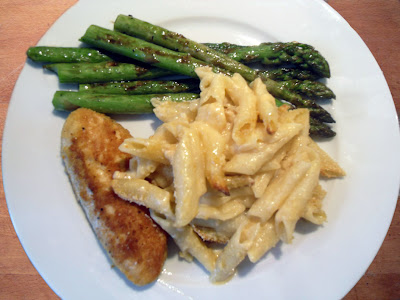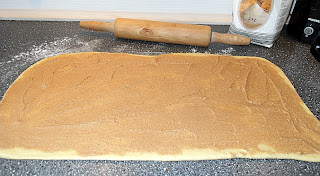I'm currently stuck in the prison that is exams. All day I spend alone in my bedroom, buried under books and notes, thinking 'til my brain hurts and typing 'til my fingers bleed. And that is exactly why I chose to cook the most time-consuming dinner I could think of! I'm really good at thinking of really important other things I probably should just get done before I can continue working on my exams - suddenly I feel an overwhelming need to wash the floors, clean the oven or bake a cake. Cooking this meal gave me a good two hour break from my studies, and it was fun, too :)
Everyone in this home (all two of us) love falafels, and we'd probably have them much more often if they didn't take so long to cook. Also, they require a little bit of thinking ahead, as you have to soak the chickpeas for about 12 hours or so before you can use them. But if you can find the time, they really are all worth it!
Flat bread (as adapted from the brilliant Danish bread blog, Brødet.
Check it out here!):
I get 12 flat breads from this recipe.
350 ml lukewarm water.
25 g fresh yeast
1/2 tsp salt
1/2 tsp sugar
(At least) 500 g flour (I used 100 g spelt flour and 400 g plain flour)
Instructions below
Falafel:
250 g dry chickpeas (Tinned won't work for falafels - I can't make them work, anyway)
A couple of big handfuls of parsley
2 red chillies, no seeds
4 cloves of garlic
1 onion
2 tsp tahini
1 tsp ground coriander
1 tsp ground cumin
2 tsp salt
1 tsp baking powder
4 tbsp plain flour
1 litre sunflower oil for frying
On the night before you want to cook the falafel, place the chickpeas in a bowl and cover with water about twice as high as the chickpeas. Leave to soak in the fridge over night.
To make both flat breads and falafels, start by making the bread dough. Dissolve the yeast in the water and add salt and sugar. Then add the flour, and get your hands in there to mix. Knead for a few minutes, and add more flour if the dough is sticking to your fingers. If it's sticking to your fingers now, it will stick to the pan later! Leave the dough to rise in your warmest room while you prepare the dough for the falafels. I left my dough for about half an hour, and it was fine.
Meanwhile, put your chickpeas into a food processor, and blitz for a few minutes, until they are roughly chopped and resemble a grainy pulp. Spoon the chickpeas into a bowl, and add to the food processor the remaining ingredients, except for the flour and baking powder. Now add about four big spoonfuls of the chopped chickpeas - This will make it easier for the other ingredients to mix. Blitz for a couple of minutes until everything is roughly chopped - you might have to spoon the mixture of the sides a few times to get everything in there. Add this mixture to the bowl of chickpeas, and mix. Now in another bowl, combine the flour and baking powder and mix well. Add it to the chickpeas, and get your fingers in there to make sure everything is mixed well, and that the flour/baking powder mix is evenly distributed. The flour binds the other ingredients together, allowing you to shape the mixture into balls later. Stick the bowl in the fridge while you make your flat breads.
Get your dough, which should have grown substantially in size by now. Remove it from the bowl, knock the air out of it, and cut it into 12 equally sized pieces. Now put a pan on the hob and get it nice and hot, I always just stick it on the highest heat possible. Don't add any butter, oil or anything to the pan. While the pan is getting hot, lightly flour a surface, take a piece of dough and roll it out paper thin. If the dough is sticking to you rolling pin, dust it with flour. You might end up using quite a lot of flour, which is fine. Take your paper thin dough and place it onto the dry, hot pan. Let it cook for about a minute on each side. While it's cooking, roll out your next piece of dough. Continue until all your 12 pieces of dough have turned into yummy flat breads! If you are stacking your flat breads on a plate as they've cooked, a good piece of advice is to keep the most recently cooked one separated from the one underneath it with a piece of baking paper. I find they stick together if they touch while they're very hot.
Back to the falafels! Get the dough from the fridge. Pour your sunflower oil into a sauté pan or just a regular saucepan and place over a high heat. With your hands, start rolling your falafel dough into small balls the size of a walnut. Every once in a while, check to see if the oil is hot enough for frying. You can do that by sticking the wooden end of a match into the oil - when the oil bubbles around the match, it's hot enough to start frying. I normally have time to roll all my falafels before the oil gets hot.
Use a spoon to place the falafels in the hot oil. I only cook four at a time - adding too many will make the oil go cold. Unfortunately, one litre of oil in my sauté pan is
just too little for the falafels to be fully emerged, so I have to turn them over once while they fry. I let them cook for a minute or two on each side, until they become golden brown. Remove from the oil, add another four, and keep going until all your falafels are cooked. While the falafels are cooking, you can chop whichever veggies you want in your flat breads with them. We served them tonight, as they would have been served by our local falafel pusher, with iceberg lettuce, cucumber, tomato, finely sliced red onion a garlic dressing. It was delicious as always, and the best news is that there is plenty left over for lunch today!




































